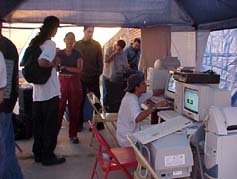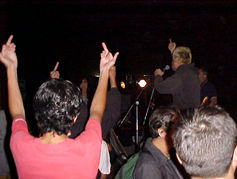|
|
|||||||||||||||||||||
BORDERHACK
2000
Fran
Ilich & Luis Humberto Rosales
In
1997, during a European event called "Documenta X," an idea for a Germany/Poland
border festival was put forward. The festival was to be in the form of a camp
where activists and artists would express their outrage towards the treatment
of illegal immigrants at this border. The camp became a reality in 1998, under
the name Kein Mensch ist Illegal (no one is illegal). In spite of several attempts
by the police to cancel and sabotage the event, cyberculture personalities,
artists, musicians, activists and human rights supporters successfully organized
marches, talks, concerts and workshops.
Three years have passed since "Documenta X" and Kein Mensch ist Illegal has grown enormously. It's no longer confined to one place. Several camps are now organized along the borders that separate the European Union with the former Soviet countries, borders where migrants are often the victims of abuse. In 2000 the camps took place with an added feature. Kein mensch ist illegal has migrated to America, more specifically, to the city of Tijuana, Mexico, considered by many the most physical and intense border area in the world. Headed by Laboratorios Cinemátik, a mixmedia group experienced in the promotion of cyberculture and electronic music, the Tijuana Kein Mensch ist Illegal camp took the name of "Borderhack!" Instead of trying to dissolve the border, the goal of the camp was to apply to it a little reverse engineering, in other words, to try to understand its structure and to discover its workings...

Excerpts from the Borderhack! Manifesto:
"That is why we propose this Borderhack, a camp that does not pretend to destroy the border, but, in a worst case scenario, only to make us conscious of it. In the world of computers, Hacking is understood as the penetration, exploration or investigation of a system with the goal of understanding it, not of destroying it, and that is exactly what we are trying to do: to understand the border, to know what it represents and to become aware of the role that we play in it. All this with the goal of improving the relations between two worlds (the first and the third), Mexico and the US. We want not only to understand why this relationship has suffered under the influence of certain sectors of society that have fostered a climate of violence and racism, but also to understand the strange attraction that unites us. And what better way to accomplish this than by doing it right on the physical border, by spending three days trying to get to the bottom of the problem and really understand what is it that unites us and what is it that separate us."
For Laboratorios Cinemátik, a group that has always lived on the border (physically as well as electronically), the camp was the logical step to take. In a way, it served as an upgrade to the work they have been carrying out since 1994, which included the First International Cyberculture Festival: Cinemátik 1.0 (1998) as well as the events done in collaborations with Calarts and Natalie Bookchin. It also served as an excuse to celebrate the third anniversary of the Cinemátik cyberculture online forum.


Borderhack materialized in Tijuana on September 1, 2 and 3 of the year 2000. The location of the camp was in the Playas de Tijuana part of the city, in front of the actual border fence that divides the third and the first world. The camp included net art, border cinema, isdn connections, conferences and workshops, not to mention the participation of the global hacktivist and net-media art community.
"The idea to synthesize the camp is born out of our condition of dilettante border kids, out of our years of crossing the border and doing a little window shopping, pretending that we could be part of the American Dream of wealth, happiness and freedom. We are confused, we accept it. On one side, the Malls are filled with happiness, and on the other, the wrong side, we are forever condemned to produce goods that we will never enjoy ourselves."
That is, unless we are lucky enough to come by a green card. This is the border. Our border. A place where we earn pesos and consume in dollars. Where we almost live in the US. Where we can smell the future coming from the freeways, from Silicon Valley, from Hollywood, but yet we are trapped in a muddy hill with unpaved streets. To reach the freeway we need a car, something that we could never afford. The only way for us to cross the border is by foot, without a penny in our pockets. We resign ourselves to earning minimum wage, to looking through store windows as if they were postcards from Europe, knowing that we could only reach the other side in our dreams. We are the good neighbors of the US, always here, always smiling, ready to serve the next margarita.
The border is unilateral, only when going from Mexico to the US. The other way around is a free zone: with no need for visas, tune ups, secondary inspections or paid permits. The border exists only when going North. The wall is "one way." Our exchange rate is 10 to 1 in favor of the dollar, of the Americans. And then, at the end of the day we ask ourselves, Kein Mensch ist Illegal (no one is illegal)? Or are we all illegal?